Modern plumbing is a marvel of engineering but can still suffer from problems. These issues often require immediate attention, such as a leaking pipe or clogged toilet.
Leaving these issues untreated could lead to hefty repair costs or even water damage throughout your home. Here are some of the most common plumbing problems that require emergency 24-hour plumbing:
Table of Contents
Leaky Pipes
Leaky pipes can cause major damage if they are repaired slowly. They can also lead to sewage and harmful gases entering your home, a huge health risk. If you notice areas of your home that are consistently damp or hear bubbling sounds from your pipes, turn off the water supply to them and call a plumber immediately.
Another telltale sign of a leaky pipe is a sudden spike in your water bill. Your home’s pipes can waste up to 90 gallons of water each day if leaking, which adds up over time and costs you money.
It’s important to have your pipes regularly inspected and maintained to ensure they’re in good condition. Neglecting a leaky pipe can result in damaged and discolored walls, which can decrease the value of your property and possibly lead to hazardous black mold growth. To prevent expensive repairs down the line, it’s advisable to enlist the services of a skilled plumber to assess and fix any plumbing issues.
Clogged Drains
When a drain becomes clogged, waste and water come back into the home, creating a mess. In addition, a blocked drain can cause foul-smelling gases.
Most drain clogs form over time as food waste, hair, soap scum, and other materials stick to pipe walls. Generally, the first sign is a sink drain or toilet that slows down when you use it.
Other clues include gurgling sounds from the pipes and a strong smell of sewage. It is important to call a plumber right away if you observe any of these signs to prevent further, more serious issues.
Some clogs are caused by foreign objects that go down the drain, like a child’s toy or metal foil. FOG (fats, oils, and grease) is another common clog culprit. When these solids cool down in the pipes, they clump together and become very hard to break down. Over time, they can build up and block the entire pipe. Minerals from hard water can also build up in pipes and create limescale that “catches” everything that goes down the drain.
High Water Bills
Many homeowners only realize they have a plumbing issue once they receive an extremely high water bill. Whether the cause of the high water bill is a leaky faucet or an untreated clogged drain, it’s important to identify and address the problem as soon as possible.
Leaky toilets and faucets can save hundreds of gallons of water per month. This is why checking indoor and outdoor faucets, toilets, and irrigation systems regularly for leaks is a good idea. A dripping faucet left unchecked can waste up to 11,000 liters of water yearly, equivalent to more than 70 loads of laundry or 290 five-minute showers.
In addition, a leaking toilet can be a health hazard because it may lead to mold growth in your home. To check for a leaky toilet, shut off all the water in your home and look around for damp spots. If you notice a leak, contact an emergency Utah plumber open 24 hours to make the necessary plumbing repair.
Frozen Pipes
During frigid temperatures, pipes can freeze if they are not properly insulated. Frozen pipes are dangerous because the pressure from the water rushing through can cause them to burst once they thaw. This issue is a common problem homeowners face and often leads to flooding in the home.
To help prevent frozen pipes, homeowners should open cabinet doors in kitchens and bathrooms with exposed plumbing during cold weather. This allows warmer air to circulate in the cabinets. In addition, letting a little bit of cold water drip from the faucets susceptible to freezing can help. It is important to not drop the temperature in your home during cold weather and to consider relocating any plumbing in unheated areas, such as the attic or garage.
When a pipe does freeze, the best way to thaw it is to apply heat to the frozen section of the pipe. This can be done using a hair dryer, space heater, or warm, damp towels. Avoid using blowtorches, propane, or kerosene heaters, as they pose a fire risk and may damage the pipe.



